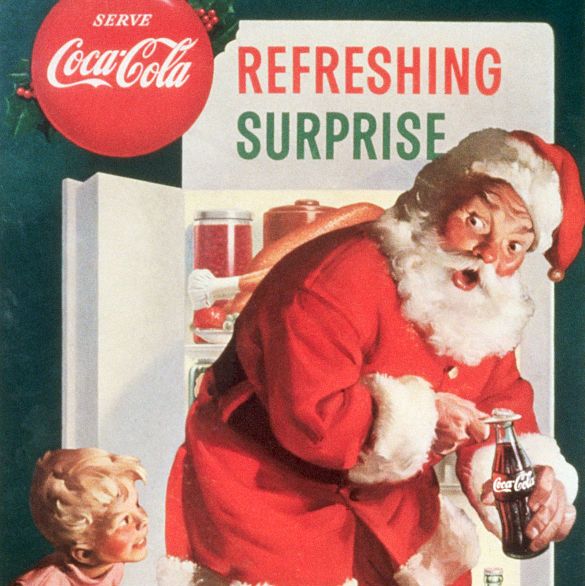
Before Coca-Cola decided to use his image for advertising,
Santa looked more spooky than jolly.
Then, in 1931, the beverage company hired an illustrator named Haddon Sundblom to depict the jolly old man for magazine ads.
Now, kids see visions of sugarplums instead of having Santa-themed nightmares.
Legend has it we hang stockings by the chimney with care because one year
a poor widowed man didn't have enough money for his three daughters' dowries,
making it difficult for them to marry.
Generous old St. Nick dropped a bag of gold down their chimney one night
and into the freshly washed stockings the girls had hung by the fire to dry.
After that, the tradition stuck!
Those letters to Santa don't always go unanswered!
In Canada, the postal code "H0H 0H0" is designated for Santa at the North Pole.
Every year, Canadian children can send their letters to this address to receive
a personalized reply from "Santa" through Canada Post's Santa Letter-Writing Program.
Rudolph the Red-Nosed Reindeer first appeared in 1939
when the Montgomery Ward department store asked one of its copywriters to create a Christmas story for kids
that the store could distribute as a promotion.
In the first year alone 2.4 million copies were distributed and late in
1949 Gene Autry recorded the song "Rudolph the Red-Nosed Reindeer".
The adorable movie featuring the island of misfit toys and Herbie the elf hit the airwaves (and our hearts) in 1964.
Rudolph the Reindeer The story of Santa’s sleigh being pulled by reindeer has been around for a while, but Rudolph only joined the gang in 1939.
Rudolph was created by Robert L. May for the retailer Montgomery Ward, who gave out coloring books every Christmas.
While coming up with the initial concept, he briefly considered calling the friendly little reindeer Rollo or even Reginald!
The story of Rudolph the Red-Nosed Reindeer was rejected at first because back in the 1930s, a red nose was considered to be a sign of a drunkard!
During World War II,
the United States Playing Card Company joined forces with American and British intelligence agencies
to create a very special deck of cards.
They distributed them as Christmas gifts to soldiers,
but they also helped Allied prisoners of war escape from German POW camps.
When wet, individual cards peeled apart to reveal maps of escape routes.
The first-ever artificial Christmas tree was a German tree made of dyed goose feathers.
Milk and cookies derive from an Old Dutch tradition of leaving food for St Nicholas on feast day.
The very first string of electric Christmas tree lights was created in 1882.
In Germany, people honored the pagan god Oden during the mid-winter holiday. Germans were terrified of Oden, as they believed he made nocturnal flights through the sky to observe his people, and then decide who would prosper or perish. Because of his presence, many people chose to stay inside.
The Legend of the Poinsettia
There is an old Mexican legend about how Poinsettias and Christmas come together, it goes like this:There was once a poor Mexican girl called Pepita who had no present to give the baby Jesus at the Christmas Eve Services. As Pepita walked to the chapel, sadly, her cousin Pedro tried to cheer her up. 'Pepita', he said "I'm sure that even the smallest gift, given by someone who loves him will make Jesus Happy."
Pepita didn't know what she could give, so she picked a small handful of weeds from the roadside and made them into a small bouquet. She felt embarrassed because she could only give this small present to Jesus. As she walked through the chapel to the altar, she remembered what Pedro had said. She began to feel better, knelt down and put the bouquet at the bottom of the nativity scene. Suddenly, the bouquet of weeds burst into bright red flowers, and everyone who saw them were sure they had seen a miracle. From that day on, the bright red flowers were known as the 'Flores de Noche Buena', or 'Flowers of the Holy Night'.
The shape of the poinsettia flower and leaves are sometimes thought as a symbol of the Star of Bethlehem which led the Wise Men to Jesus. The red colored leaves symbolize the blood of Christ. The white leaves represent his purity.
Read more Trivia.